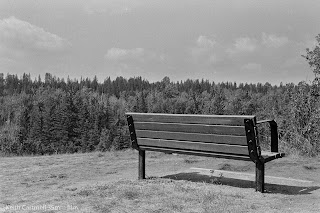There's been some bumps on the film road. I'd taken the Canon 7 out on Canada Day for some street photography and ended up having some problems with it. Eventually it locked up entirely. I just got the film back, and let's just say the results were interesting. There's some good frames, and lots of overlapping overexposed frames. My next project is to scan those particular rolls.
Mid July I attended a B&W photography session through The Camera Store. They gave us each a roll of Illford HP5+ ISO 400 film. At this point I didn't have a functional 35mm camera so I took the big medium format camera. I haven't finished that roll yet.
Shortly after that I found out the Canon 7 needed major repair work. It needs a complete disassembly and cleaning, and who knows how many parts are worn and need to be replaced. (If you want to take on this project, comment below.)
I was looking to see what another one would cost compared to the cost of repairs, and found an EOS-3 for sale. This is one of the last film cameras made before digital took over, and was aimed at the so-called 'pro-sumer' market. It was what I had first looked for in a film camera, but couldn't find any locally, and went with the Fujica GW690.
In many ways it's a digital camera that uses film rather than a sensor. I traded in the lens for the Canon 7 and the EOS-3 was mine. The partial roll I'd rescued from the Canon 7 lockup was the first roll in, just to run it through the camera and see how things worked. Just looking at the negatives things appear just fine.
Then the HP5+, wanting to capture a variety of scenes to see how the film responded, plus work with the camera a bit more. I'm still learning to expose B&W film because what works for colour doesn't always work for B&W and vice versa.
Conclusions first. The EOS-3 is a dream to use, and that's before trying the eye focus system. I'm told it's unreliable if the user is wearing glasses with an antireflective coating, which I do. The controls are intuitive if you've been using a Canon 5 or 6 series digital. It handles well, and takes EF lenses. I think all these were taken with my 24-105mm lens. I've since picked up a 50mm lens, and can't wait to try that out.
The viewfinder is bright and clear, but the exposure compensation is vertical on the right side and it seems to pick up reflections that make it hard to see. I solved this by wearing a hat, which I normally do during photo sessions anyway. It's a similar size and weight to my 6D, and the shutter click is quite loud, so this isn't a stealth street photography camera. I might write more about the camera after I use it more.
The presenter (I think it's Chris Donovan) noted this is a forgiving film with wide latitude for exposure and pushing or pulling. I exposed these at box speed, aiming for a normal exposure, but looking for scenes with both dark shadows and bright light. Negatives were developed by Paul Stack, but I don't know the specifics. The negatives were digitized by me using a camera and a good macro lens, then inverted in Negative Lab Pro. Except where noted below, there was very little editing in NLP, typically increasing contrast a bit, and making the darks a little darker. In Lightroom there was only a bit of cropping and dust spot removal.
Out of the 36 exposures, all were in focus and nicely exposed. There's only 25 below, with the others being poor photos or having enough dust spots on them that I want to redo the digitization process.
1. Linda in afternoon sun. She might be slightly under exposed since there's a bit of grain showing.

























No comments:
Post a Comment
Looking forward to reading your comments.